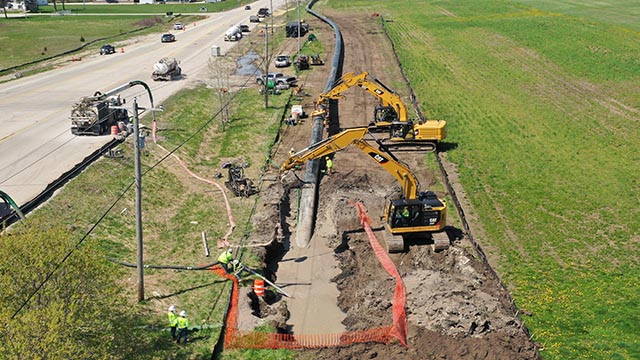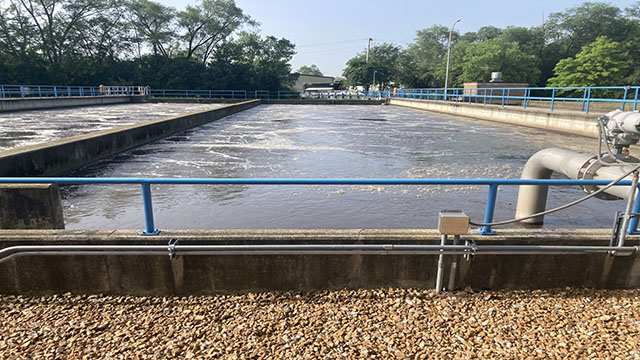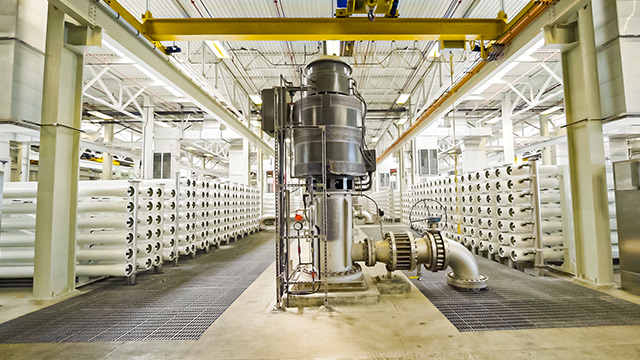Having always called Memphis home, Brad Davis knows as well as anyone that the story of that iconic “Home of the Blues” along the Mississippi River is a complicated one, right down to the most ambitious, unfolding infrastructure makeover the city has ever undertaken.
The same city that swaddles itself in musical influencers Elvis Presley, B.B. King and Johnny Cash as its favorite sons also is known for pain and struggle. Anguished strains of blues ooze from Beale Street’s clubs, not far from the former motel that’s now the National Civil Rights Museum.
But more than anything, this barbecue-revered place where Davis attended local schools, earned a college degree, served as an assistant city engineer and now raises his family is steeped in moxie and pride. And all of it is underscored by the sweeping sewer system improvement program that Davis proudly helps oversee for Kansas-based Black & Veatch, the global engineering and construction giant that hired him especially for the job.
Black & Veatch is providing comprehensive program management services to the city of Memphis for the colossal, $350-million Sewer Assessment and Rehabilitation Program – known officially as “SARP10,” with the “10” denoting the program’s decade-long time frame. The program includes numerous infrastructure improvement projects across the entire system. In addition to program development and management, Black & Veatch is providing public relations and community outreach, financial review and management, and modeling/analyses. The company also is supplying development and management of the collection system monitoring, operations and maintenance program, as well as regulatory reporting and rehabilitation prioritization, design and construction delivery.
And all of it is aimed at helping Memphis achieve compliance requirements by 2023.
Not unlike sewer systems in other old, big U.S. cities, the 3,200 miles of sewers – the equivalent of driving from Seattle to Miami – woven beneath two-centuries-old Memphis never commanded much public notice because it’s all buried. But over time, the system’s deterioration and the resulting overflows of untreated sewage onto streets or yards or into basements and streams became chronic enough that, at the federal government’s behest, Memphis agreed through a 2012 consent decree to fix it.
By many metrics, the decade-long program is a triumph in the making. Sewage overflows have plunged by nearly two-thirds since the work began in 2013, offering environmental and health benefits. In the roughly 650,000-resident city that’s predominantly black, more than one-third of the work is entrusted to minority- and women-owned businesses. And the program is on track, in large part because the absence of any serious injuries on the job sites has kept work from being disrupted.
Sewer work certainly isn’t glamorous. But as with the system itself, this program is more about what lies beneath: a palpably better way of life for stakeholders, and the promise of greater economic development from the jobs and tax revenues that come with a sewer network resilient enough to support Memphis’ water quality and economic growth.
“I love the fact that I’ve gone to work on a program that I knew would be helping the city in sort of an unseen way,” Davis said as the deputy program manager, relishing his role as a steward of the program’s funding.
“The city doesn’t have a lot of resources and doesn’t have a lot of extra money that some cities have,” he added, “so we have to make sure we deliver value on every dollar spent. (Taxpayers) are trusting us with that money to make sure we’re getting a good return on it.”

Anatomy of a Challenge
While consistent in scale with other metropolitan areas, Memphis’ sewerage assets might appear numbingly complex to the layperson: 102 lift stations, along with thousands of miles of piping ranging in diameter from 6 to 120 inches. On average, the city’s two big wastewater-treatment plants process more than 60 billion gallons of wastewater each year, disposing of more than 215 million pounds of biosolids.

But age – some of Memphis’ sewer pipes are a century old, and construction of the system there began in the 1870s – took its toll. Pipes deteriorated and cracked. Joints parted. Roots penetrated pipes, and corrosion has eaten away conduits and manhole covers. Things such as common household grease poured down kitchen sinks also left buildups over time in underground pipes, adding to the problem by disrupting flow in the 870,000-customer service area sprawling over 340 square miles, including a snippet of Mississippi.
Eventually, as was the case in many U.S. cities, the federal government – notably the Environmental Protection Agency – and Tennessee oversight agencies stepped in as part of a nationwide push to keep raw sewage and tainted stormwater out of streams, rivers and lakes. Memphis sought reform over such unpermitted sewage discharges, leading to the city’s negotiated 2012 consent decree that demanded the rehabilitation and updating of the sprawling system.
As part of that deal laden with timeline and performance benchmarks and metrics for Memphis to meet, the city also had to adopt a continuing plan to assess and maintain the system’s health. Any trouble that arises must then be swiftly remedied.
With significant regional experience, its local commitment and laudable record in carrying out similar large programs, Black & Veatch was selected to drive the comprehensive SARP10 program from inspection and assessment through prioritization, design and construction delivery.
Embracing the Opportunity
Any time regulators require a community to rid a system of problems so many years in the making – at a price that stakeholders in a financially challenged place hadn’t yet envisioned paying – it can be a bitter pill to swallow.
But as Memphis’ public works director, Robert Knecht sees the decree as simply a blessing. And an opportunity, pointing to the master plan the city now has for the sewer system being modernized largely through rate revenues, complemented by bonds and loans.
Before launching into the program, Knecht admits, “we were struggling” to manage the wastewater system in a holistic way, which helped explain the system failures manifested by overflows. To Knecht, it was a Band-aid approach to issues with a system that had exceeded its life expectancy.
The decree, he said, “forced us to take a very hard look” at all of that.
“None of this would have happened if we hadn’t embarked on this consent decree program so we could be more strategic, more creative, more cost-efficient and cost-effective,” he added. “It also makes you look at that dynamic, comprehensive nature of your system. You’re looking at its future so you’re not chasing your tail, you’re not making these reactive decisions. The goal of being ultimately as proactive as possible is invaluable. I mean, that’s huge.”
Codeword: Thoroughness
Under the aggressive, ambitious program, no stone has gone unturned.
The curious sight of smoke has been spotted here and there seeping from random streets and lawns – a tool used by crews to pinpoint cracked conduits. Closed-circuit television cameras have been threaded throughout the subterranean labyrinth of pipes, sleuthing out defects that then are logged and prioritized for repair. Everything gets digitally mapped, giving the system’s overseers an intricate, instant blueprint – accessible with a few clicks of smart phones or electronic tablets – of all assets, including such details as when a pipe was last inspected.
A lot of the work, including scouring all sewers to rid them of troublesome buildup, has gone well beyond the decree’s mandates.

“It’s a good story. We’re cleaning the system, we’re assessing everything, and we’re starting to get a lot of big return on investments. Now comes the challenging part – trying to just keep driving home the last little bit that we can to keep getting those (overflow) numbers down.”
- Scott Morgan, City of Memphis Senior Environmental Administrator
Always, Safety First
From the heights of crane work and girders to the depths of tunnels and trenches, rehabbing sewers is perilous. Any shortcuts or attention lapses, even for an instant, could cost a limb or a life.
It makes the safety record on the Memphis program truly remarkable. More than 900,000 man-hours on the job had been completed as of late summer in 2019 - with no lost-time incidents. That’s the equivalent of 10 people working for 45 years without accident-related down time.
“At the end of the day, we want to be able to say anybody who’s working on this program goes home to their family,” said Bently Green, the program manager for Black & Veatch. He considers the Memphis safety showing “phenomenal -- and one that we’re very proud of.”

The feat is no accident. Black & Veatch’s safety practices have been shaped by the crucible of its more than a century of solving the world’s infrastructure dilemmas, and the company doesn’t flinch about sharing the best practices it has learned and honed.
In early 2018, Black & Veatch mentored dozens of local supervisors and contractors in the Memphis program, offering free seminars about such things as regulatory requirements, mitigation of hazards no matter how small, fall protection, and excavation and forklift safety. Everything wrapped in the belief that prizing safety in a notoriously hazardous line of work protects crews and the public – with the added benefit of keeping the program on track and on budget.
Memphis contractor Wiley Richards – along with his brother, a fellow vice president in two-decade-old, family-run W&T Construction – deemed the tutelage “high-end” – and so invaluable that they’ve passed it on to the minority contracting company’s two-dozen employees.
“We certainly have tried to operate in a safe manner, but we lacked some protocols,” Richards said, lauding the workshops accredited by the National Center for Construction Education and Research. “We want our employees to have a safe work environment, and we’re very thankful to (learn from) an organization that clearly believes people are important, that people matter, and that our people are paramount and critical.”
‘Cleaner environment, better quality of life’
Like Black & Veatch’s Davis, Michael Hooks Jr. is Memphis born and reared. And as the founder in 2010 of local Allworld Project Management, he found success in fixing big things. With more than 40 full-time employees – a mix of engineers, project managers, architects, accountants and urban planners – at a company that’s essentially the sewer program’s deputy manager, Hooks is thrilled to have the chance to give back to his hometown with the sewer system upgrade that has helped many minority-owned contractors grow in size and capability.
“We’ve been blessed with the ability to work on a multitude of ‘feel-good’ and ‘do-good’ projects under the program,” Hooks said. “But particularly, (this sewer program) is one where people can see direct, tangible benefits as a result of our hard work. The individuals that work every day on the program get an opportunity to see how their efforts contribute to a cleaner environment, a better quality of life.”













